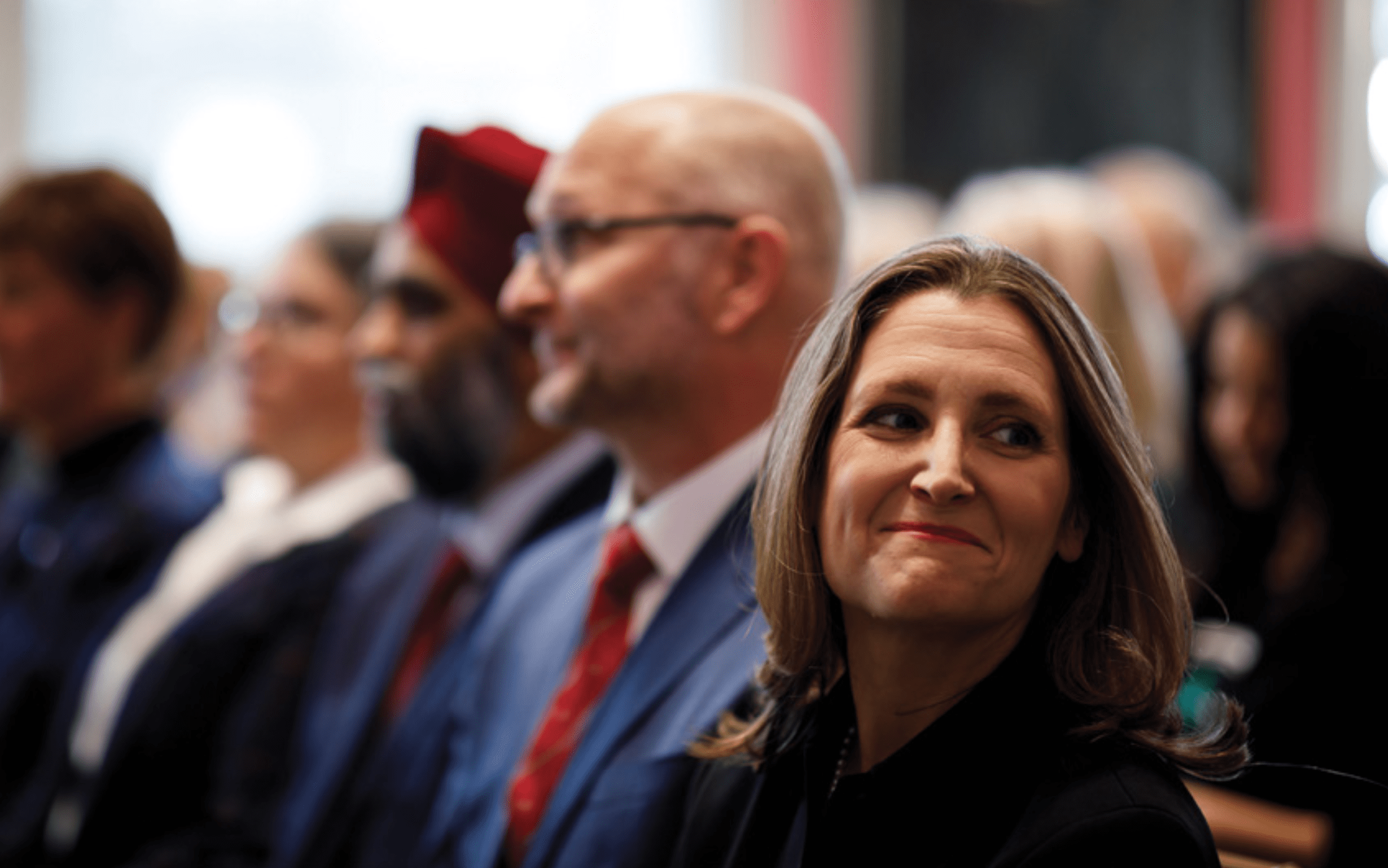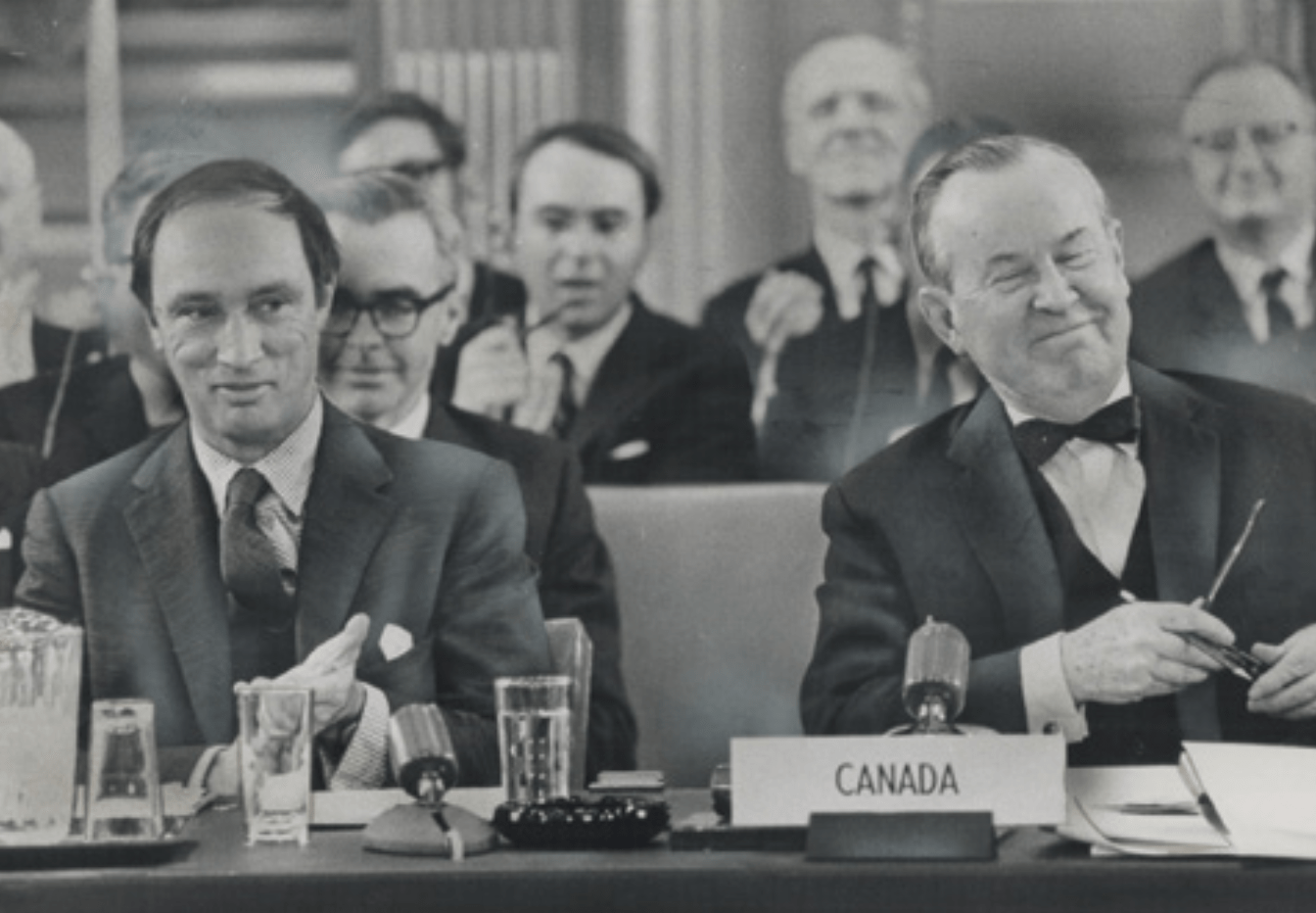Chrystia Freeland’s Domestic Pearsonian Mission

In facing Donald Trump’s surrogates in the NAFTA II negotiations, Chrystia Freeland proved she could navigate the novel conflict terrain of triangulated social media pressure and weaponized trade tweets. As veteran Liberal strategist John Delacourt writes, the environment of her new fed-prov mandate may not look that different.
John Delacourt
You could take it as an auspicious start to the 43rd Parliament. As the Liberals returned to Ottawa for the new session under grey skies, with fresh snow on the ground, their second throne speech strained to summon a few bright beams of inspiration from the sunny ways of 2015. Justin Trudeau’s team is ostensibly chastened; the aspirations of their minority mandate were reflected less in the top line messages adroitly woven through the Speech from the Throne than in the last paragraphs, in a quote from the late Liberal prime minister and Nobel Peace Prize laureate Lester B. Pearson:
“Tonight, we begin a new chapter in our country’s story. Let the record of that chapter be one of co-operation and not conflict; of dedication and not division; of service, not self; of what we can give, not what we can get. Let us work together as Canadians to make our country worthy of its honoured past and certain of its proud future.”
Such sepia-toned optimism. Prime Minister Pearson spoke those words on December 31, 1966, as he lit the Centennial Flame for the first time in front of the Parliament Buildings.
At that moment, Pearson could look back on nearly four years and two terms of the most successful minority parliament in Canada’s history—and probably the most successful Canada will ever experience. It was a government that managed to introduce the Canada Pension Plan, our health care system—and our Maple Leaf flag. It was capable of bold thinking and ambitious projects, and an implicit transactional rapport among all parties, regardless of the requisite theatrics in the House, to get those projects done.

Pearson’s speech, televised to a baby boom generation not yet old enough to vote, resonated strongly to Canadians who could be realistically assured of playing a part in this “proud future.” The lines of division between the provinces and the parties were less pronounced. The coarsened, polarized rhetoric of free-ranging hostility and alienation had yet to emerge, perhaps because it didn’t have the echo chambers of two social media platforms to enable it.
Pearson could look south to our largest trading partner and be assured of a congenial reception for any bilateral with President Lyndon B. Johnson, a figure as historically remote as a Roman senator in relation to the current U.S. president. And perhaps most important as a point of differentiation between now and then, fears of climate change and “extreme weather events” would have seemed like the most dystopic of science fiction tales to Pearson’s electorate.
If the first four years of Trudeau’s Liberal government are any indication, the chapter in the country’s story this parliament is fated to write features a shift in the dynamics of executive leadership itself. Trudeau’s team within the Prime Minister’s Office began this subtle recalibration of statecraft back in early 2017.
This was when it became clear the Trump administration’s plans to rip up the North American Free Trade Agreement could send our economy into a tailspin, and that the government’s best person on the front line to negotiate the new agreement was Chrystia Freeland, backed by a dream team of senior officials and staffers working closely with Ambassador David MacNaughton’s office in Washington.
The drama and high-stakes crisis management this team worked through over the last three years is a story that has yet to be written. But any conversation with those close to the Canada-U.S. file will confirm for you that Freeland and team pulled off a remarkable feat with the newly signed agreement, despite the damage the negotiations have caused to the steel and manufacturing sectors in particular. For anyone close to the centre of this government, it is considered the signal achievement of the first four years. As the bill is set to move quickly through the House now, Freeland’s political capital is both affirmed and enhanced around the cabinet table.
There were two principles behind the best practices of Freeland and team. First and foremost: no negotiating in public. Throughout the many scrums Freeland lived through over the last three years, she perfected a technique of saying just enough that the news media had a sense of the direction negotiations were taking while revealing virtually nothing about how marked the divide might have been in intentions and objectives across the table.
The second principle: execute a “doughnut strategy.” This is a process of building political capital among the influencers on policy outside the inner circle of decision making. As the political capital accumulates the pressure from these influencers increases. The result: intractable positions at the start of the negotiations begin to shift and soften. Win-win propositions begin to emerge. Given the burgeoning chaos at the heart of the Trump administration, that such a strategy actually worked is a minor miracle.
Now, with Freeland in the role of deputy prime minister, that strategy will be directed where it is needed most: at the intergovernmental level. To see a portrait of the first ministers in 2019 is to acknowledge that there is a remarkably different cast of characters than those around the table in 2015. British Columbia’s Christy Clark, Ontario’s Kathleen Wynne and Alberta’s Rachel Notley have been replaced by premiers who, in gender and age, look a lot more like Trump’s inner circle. The Liberals have no illusions about the tense negotiations that will take place on carbon pricing, on universal pharmacare and, with perhaps the most difficult of conversations, on support for the energy sector in its transition to a radically different economy over the next two decades.
More worrisome for Trudeau is the potential impact of this dynamic on federal party politics. Earlier this year Jason Kenney’s United Conservative Party (UCP) and Doug Ford’s Progressive Conservatives (PCs) did some interesting, strategically savvy polling on whether their voters would give their leaders licence to take on the federal government on issues that were not necessarily provincial in nature; in essence, were both able to cut Andrew Scheer’s grass and not pay for it in terms of political capital.
The results were encouraging, if you were a premier with designs on an eventual federal run. In contrast to the challenge the Liberals face from Legault’s Coalition Avenir Québec (CAQ) and Blanchet’s revived Bloc Québécois (BQ), neither Ford nor Kenney have stuck to their knitting and solely spoken to what they deem good for their respective provinces; they have taken on the mantle of speaking for the larger Conservative project—on regional alienation, on national unity, on the potential of a resurgent conservatism that Andrew Scheer failed to grasp. To be Justin Trudeau in a room with such potential adversaries is to limit the scope of what can be achieved.
Where Freeland and team have excelled is in their diligence in swaying influencers among those who would be inclined to work more congenially with Conservative governments. During the worst of the negotiations with the U.S. on the Section 232 steel tariffs, Freeland surprised by her accessibility and responsiveness, texting CEOs to provide them with updates and to hear their concerns. She accomplished this without sacrificing any of the discretion and confidence high level negotiations required. She can achieve that magical balance of being perceived as both principled and tough, flexible and constructive. Chief negotiators and key stakeholders all come away from their interactions with Freeland and her team with at worst a begrudging sense of respect. More often than not, it’s admiration for how well she knows her files and how ably she manages difficult conversations.
With the release of the cabinet mandate letters on December 13, we now know what we already knew—Freeland will continue her oversight role on Canada-U.S. relations along with her other responsibilities.
And, as any colour-coded map of party seats in each province and territory will confirm, her mandate in intergovernmental relations will be to stitch together a functioning dialogue from a stark patchwork of regional interests. To create, as Pearson hoped, “co-operation not conflict … dedication and not division” is to fulfill a promise that requires more than the prime minister’s tarnished charisma and renewed focus on caucus management. It will require the transposition of Freeland’s winning strategy into an arena that may prove even more challenging than dealing with Trump.
Contributing Writer John Delacourt, Vice President and Group Leader of Hill + Knowlton’s public affairs practice in Ottawa, is a former director of communications for the Liberal Research Bureau. He is also an author of three books.
